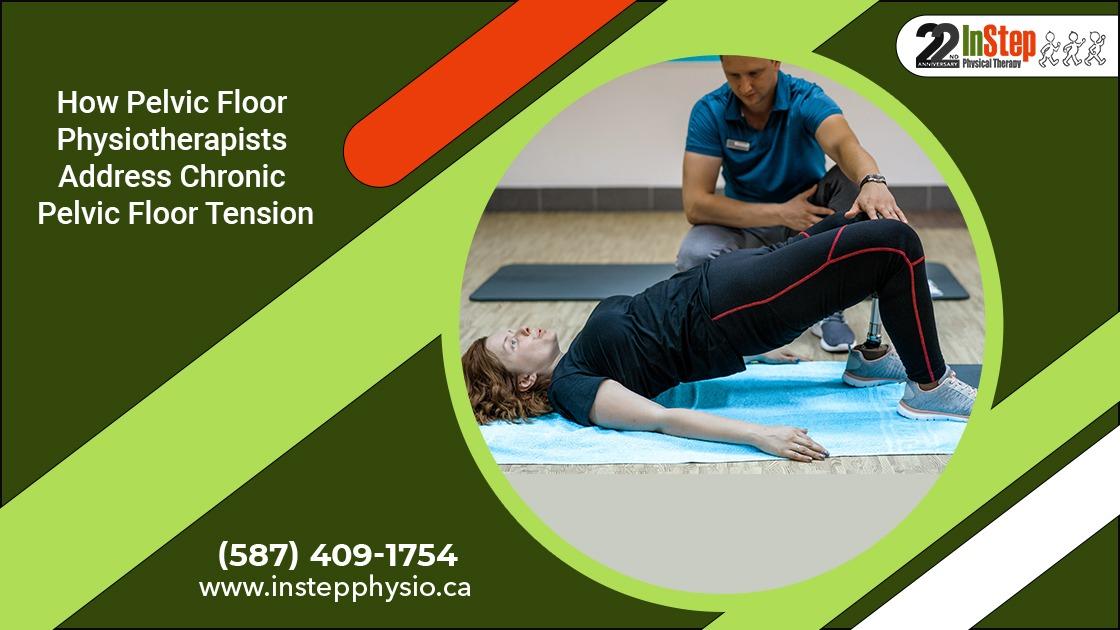Chronic pelvic floor tension is more common than you might think, yet it often goes untreated. If you've been dealing with persistent discomfort, pain during certain activities, or issues with bladder or bowel control, your pelvic floor might be the culprit. Fortunately, pelvic floor physiotherapy in Edmonton offers tailored care to address this condition. Through targeted therapies and personalized exercise programs, tension can be relieved, normal function can be restored, and quality of life can be improved. For those dealing with ongoing pain or other symptoms related to pelvic floor tension, finding lasting relief through pelvic wall therapy is possible.
What is Chronic Pelvic Floor Tension?
Chronic Pelvic Floor Tension is a condition where the muscles in the pelvic floor remain overly contracted for extended periods, leading to persistent pain, discomfort, and a range of symptoms such as urinary issues, bowel dysfunction, and sexual pain. This tension can be caused by factors like stress, injury, childbirth, or poor posture. It significantly impacts a person's quality of life by causing physical discomfort and emotional distress, making everyday activities and intimate relationships challenging. Without proper management, the condition can result in chronic pain and long-term complications, affecting both physical and mental well-being.
The Role of Pelvic Floor Physiotherapists:
Pelvic floor physiotherapists are trained to assess and treat the muscles, joints, and nerves that contribute to chronic pelvic floor tension. Their approach is holistic, considering not just the pelvic floor itself but how it interacts with the rest of your body. Here's how they address the condition:
Comprehensive Assessment
Your journey with a pelvic floor physiotherapist starts with a thorough assessment known as Pelvic Floor Dysfunction Assessment. This evaluation goes beyond the pelvic floor, examining the whole body. The therapist will gather a detailed history, including symptoms, lifestyle, stress levels, and any prior injuries or surgeries. A physical examination, which may involve an Internal Pelvic Floor Muscle Assessment, will be conducted to evaluate the tone, strength, and coordination of the pelvic floor muscles.
Individualized Treatment Plan
Based on the assessment, your physiotherapist will offer a treatment plan designed to tackle your specific needs. Pelvic floor physiotherapy in Edmonton utilizes a combination of the following techniques:
Manual Therapy:
Pelvic floor therapy uses hands-on techniques to help relax and stretch the pelvic floor muscles. This could include internal or external massage, trigger point release, and stretching of the surrounding muscles, such as the hips and lower back.
Myofascial Release: This technique involves applying gentle pressure to the fascia (connective tissue) surrounding the pelvic floor muscles to release tension and improve mobility.
Trigger Point Therapy: Trigger points, also called knots in the muscles, can cause discomfort. By applying sustained pressure to these points, physiotherapists can help release these tight spots and alleviate associated symptoms.
Internal and External Massage: Both internal and external massage techniques may be used to target the pelvic floor muscles directly. Internal massage is performed with care and sensitivity, often in collaboration with the patient's comfort level, to alleviate tension in the deeper muscles of the pelvic floor.
Biofeedback:
Biofeedback is a technique where sensors are used to provide real-time feedback on muscle activity. This can help you become more aware of your pelvic floor muscles, allowing you to learn how to relax and control them better.
Surface Electromyography (sEMG): Sensors placed externally on the skin or internally within the pelvic area measure the electrical activity of the pelvic health muscles. This data is displayed on a screen, helping individuals see when their muscles are tense or relaxed, promoting better control over muscle relaxation.
Pressure Biofeedback: A sensor is inserted into the vagina or rectum to measure changes in pressure exerted by the pelvic floor muscles. This feedback helps individuals learn to properly engage or relax the muscles without over-contracting them.
Pelvic Floor Exercises:
While Kegels (exercises that involve contracting and relaxing the pelvic floor muscles) are often recommended, they're not always appropriate for everyone. Female pelvic floor physiotherapy offers specific exercises tailored to your needs, which might involve learning how to relax rather than strengthen your pelvic floor muscles.
Diaphragmatic Breathing (Deep Breathing): This technique encourages the pelvic floor muscles to relax in sync with the diaphragm. Slow, deep breaths help lower tension in the pelvic floor, promoting muscle relaxation.
Pelvic Floor Drops (Reverse Kegels): Instead of contracting the muscles like in Kegels, pelvic floor drops involve consciously relaxing and releasing the pelvic floor muscles. This helps reduce overactivity and encourages a state of relaxation.
Modalities:
Pelvic health physiotherapy offers a range of modalities to reduce muscle tightness, alleviate pain, and promote relaxation for treating chronic pelvic floor tension,
Shockwave Therapy: Shockwave therapy uses acoustic waves to improve blood flow and minimize muscle tension, making it an effective option for chronic pelvic floor tension. This non-invasive treatment helps release deep muscle tightness and promote healing.
Dry Needling: Dry needling targets trigger points in the pelvic muscles to release chronic pelvic floor tension. By deactivating overactive muscles, it helps reduce pain and improve relaxation in the pelvic region.
Ultrasound Therapy: Ultrasound therapy provides deep heat to treat chronic pelvic floor tension. The heat improves blood circulation and muscle elasticity, helping alleviate tightness.
Achieving Comfort and Confidence:
Chronic pelvic floor tension can significantly impact your quality of life, but with the right care and guidance, relief is possible. By working closely with our physiotherapist at In Step Physical Therapy in Edmonton, you can regain control, reduce discomfort, and restore normal pelvic function. Pelvic floor physiotherapy in Edmonton helps in managing chronic pelvic floor tension and allows you to move forward with improved comfort and confidence.
It's important to remember that men also experience pelvic floor issues, including chronic tension, pain, and dysfunction. Male pelvic floor physiotherapy offers specialized care to address these concerns, and there's no need to feel ashamed or embarrassed to seek help. Openly discussing your symptoms is the first step toward finding effective treatment and improving your overall well-being.
Read More.. 21 Best Alternatives of Manga Stream to read manga Instantly Best Crazy Games For Childrens How to make selfies with dorian rossini What Happened to Konami The 13 best things to do in the ICELAND 6 Things to Know About Wrongful Death Suits How to increase your customer numbers How to Manipulate Online Slots Know Lab Made Loose Diamonds in Easy Steps 5 Best Winter Fashion Style Tips 5 Best Work From Home tips You should know The 5 Best Budget Friendly Hair Dryers 5 Best Fruit for Babies Diet Methods of Freight Rate Quotes Advantages of Road Freight Understanding Search Engine Optimization in the Competitive Marketplace Tips to Winning Big in Online Casino GPHR Certification Make Your Target Challenges Facing Shippers Transport Top 5 Methods for Online Slots 10 Daily Habits to Keep a House Clean and Tidy Calgary Window Reviews Lux Windows versus Jeld Wen Windows and Doors The Black 411 Announces Plans An Ultimate Guide for CompTIA SK0-005 Exam by Exams4sure List of Few Best Gaming APIs Like Escape from Tarkov, Fortnite API and More How to Get a Used ATV or UTV on the Economical Buying guide for Lighting Reasons Why Regular Website Maintenance Is Important Tips to make your Beauty Beds Last Longer 123Movies Watch Movies Free Online Where to birthday cake order in kohara Finding the Best Freight Shipping Quotes Top 10 Nursing Trends That Will Shape Healthcare Basic Safety Measures For Athletes’ Protection Repair Or Replacement What Does Your Tyre Need VoIP headsets Heads Free Head Set Zone Trending App Ideas for Beginners 8 Reasons to Maintain Up to Date Bookkeeping The best international high schools in Tokyo Japan On Site Rigging Services For The Transportation Industry 5 Ways to Improve Team Communication and Collaboration Why Should You Hire Professional Roofing Contractors in Daytona Beach How To Live A Balanced Lifestyle With Work In Canada Tips to enhance your IGTV Videos Best Furniture For Home in Dubai
Also read about:
LIST OF THE MOST POPULAR COFFEE TABLES FOR YOUR HOME
Contract Law Attorneys at Najla Law Firm
Best Furniture Shop in UAE
















